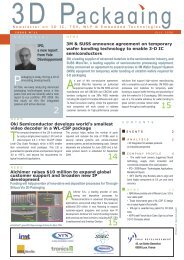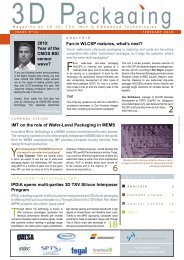September 2011 - I-Micronews
September 2011 - I-Micronews
September 2011 - I-Micronews
Create successful ePaper yourself
Turn your PDF publications into a flip-book with our unique Google optimized e-Paper software.
I S S U E 1 3 S E P T E M B E R 2 0 1 1<br />
is said to cleanly remove the oxide without<br />
damaging the glass. Work on the P1 scribe for CdTe<br />
thin film shows potential to reduce process steps<br />
by leaving intact a barrier layer which prevents<br />
sodium from the soda-line glass diffusing into<br />
the scribe and poisoning the CdTe. Typically the<br />
CdTe P1 scribe removes the barrier layer and must<br />
therefore be backfilled with a planarizing filler to<br />
avoid sodium diffusion. The tailored pulse laser,<br />
however, can etch precisely through only the TCO<br />
on the architectural glass substrate, leaving the<br />
underlying SiO 2<br />
barrier layer intact.<br />
Other work with the Fraunhofer Institute in<br />
Michigan found that the shaped beam laser was<br />
much faster than conventional lasers for drilling<br />
the thousands of hole per second across the<br />
wafer needed for emitter wrap through solutions.<br />
Practical mass production of EWT will likely need<br />
drilling some 10,000 holes across the wafer at<br />
one wafer per second without too much damage,<br />
while a conventional 100W laser can only do about<br />
4,300 holes per second. ESI’s 25W tailored-pulse<br />
laser drilled 6,800 holes per second in the tests<br />
in the Fraunhofer lab. Murison says ESI has since<br />
made considerably more improvement in its own<br />
lab as it has learned more about how light actually<br />
interacts with silicon. The solution turns out to be<br />
tailoring the pulse to first heat up the silicon before<br />
hitting it hard, which enables the material to use<br />
the available energy more efficiently. Typically<br />
a laser drills quickly down through the first part<br />
of the hole as the silicon melts, but then about<br />
halfway through the process slows down as the<br />
silicon starts to boil and vaporize, filling the hole<br />
with silicon plasma that absorbs the laser light.<br />
The relatively low 25W power of the ESI pulseshaped<br />
laser currently limits the throughput of<br />
removal processes, and so limits use for a number<br />
of c-Si solar laser applications. The company<br />
is currently working on the tricky business of<br />
developing a higher power version, as pulsetailoring<br />
is typically only possible at relatively<br />
low power. Unlike a standard Q-switching laser,<br />
where the energy is stored up then all released<br />
in one flash that can’t be precisely controlled, the<br />
fiber laser’s low power continuous beam can be<br />
shaped by an optical modulator. The PyroPhotonics<br />
technology controls the modulator by changes in<br />
voltage, for faster response rate than changing<br />
the current. The beam must then be amplified to<br />
be most useful. The founders say their approach<br />
allows very precise control of the shape at low<br />
power, so the beam remains tailored even through<br />
the distortions created by amplification.<br />
www.esi.com<br />
Richard Murison, CTO and Director<br />
of Product Marketing,<br />
PyroPhotonics Lasers<br />
Richard Murison received his BSc in<br />
Physics from Loughborough University of<br />
Technology, UK and is Chief Technology<br />
Officer and Director of Product Marketing<br />
at PyroPhotonics Lasers, a subsidiary of<br />
ESI, Inc.<br />
Tullio Panarello, General Manager<br />
of the Laser Business Unit, ESI<br />
Tullio Panarello serves as the General<br />
Manager of the ESI’s Laser Business Unit.<br />
Mr. Panarello joined ESI in <strong>September</strong><br />
2010 following the acquisition of<br />
PyroPhotonics Lasers, Inc. He co-founded<br />
PyroPhotonics in 2003 and served as the<br />
company’s CEO.<br />
Register<br />
today<br />
To attend editorial webcast<br />
Additional webcast topics:<br />
• Sept. 28:<br />
Benefits and perspectives<br />
of Cu-Pillar bumping<br />
• Oct. 18:<br />
Thin wafer handling<br />
& processing<br />
•Nov.8:<br />
Glass emergence<br />
into the semiconductor<br />
wafer-processing world<br />
Join the live webcast:<br />
On October 26 th -8:00AMPDT*<br />
PV inverter<br />
Technical Innovations<br />
and Market Trends<br />
Attend the live webcast to learn about the PV inverter market trends<br />
associated with some major technical innovations!<br />
For more information and to register, please go to<br />
www.i-micronews.com/webcasts.asp or click here.<br />
Hosted by<br />
Powered by<br />
*8:00 AM San Francisco; 5:00 PM Paris, 12:00 AM Tokyo<br />
P V M a n u f a c t u r i n g<br />
15
















